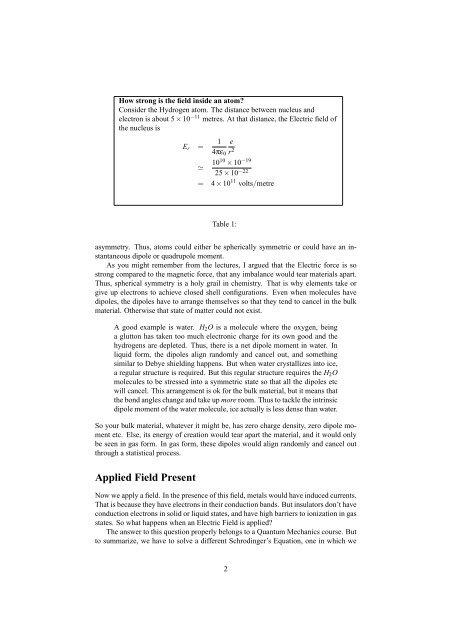The Dielectric Constant and the Displacement Vector
The Dielectric Constant and the Displacement Vector
The Dielectric Constant and the Displacement Vector
Create successful ePaper yourself
Turn your PDF publications into a flip-book with our unique Google optimized e-Paper software.
How strong is <strong>the</strong> field inside an atom?Consider <strong>the</strong> Hydrogen atom. <strong>The</strong> distance between nucleus <strong>and</strong>electron is about 5 × 10 −11 metres. At that distance, <strong>the</strong> Electric field of<strong>the</strong> nucleus isE r =1 e4πε 0 r 2≃1010 × 10 −1925 × 10 −22= 4 × 10 11 volts/metreTable 1:asymmetry. Thus, atoms could ei<strong>the</strong>r be spherically symmetric or could have an instantaneousdipole or quadrupole moment.As you might remember from <strong>the</strong> lectures, I argued that <strong>the</strong> Electric force is sostrong compared to <strong>the</strong> magnetic force, that any imbalance would tear materials apart.Thus, spherical symmetry is a holy grail in chemistry. That is why elements take orgive up electrons to achieve closed shell configurations. Even when molecules havedipoles, <strong>the</strong> dipoles have to arrange <strong>the</strong>mselves so that <strong>the</strong>y tend to cancel in <strong>the</strong> bulkmaterial. O<strong>the</strong>rwise that state of matter could not exist.A good example is water. H 2 O is a molecule where <strong>the</strong> oxygen, beinga glutton has taken too much electronic charge for its own good <strong>and</strong> <strong>the</strong>hydrogens are depleted. Thus, <strong>the</strong>re is a net dipole moment in water. Inliquid form, <strong>the</strong> dipoles align r<strong>and</strong>omly <strong>and</strong> cancel out, <strong>and</strong> somethingsimilar to Debye shielding happens. But when water crystallizes into ice,a regular structure is required. But this regular structure requires <strong>the</strong> H 2 Omolecules to be stressed into a symmetric state so that all <strong>the</strong> dipoles etcwill cancel. This arrangement is ok for <strong>the</strong> bulk material, but it means that<strong>the</strong> bond angles change <strong>and</strong> take up more room. Thus to tackle <strong>the</strong> intrinsicdipole moment of <strong>the</strong> water molecule, ice actually is less dense than water.So your bulk material, whatever it might be, has zero charge density, zero dipole momentetc. Else, its energy of creation would tear apart <strong>the</strong> material, <strong>and</strong> it would onlybe seen in gas form. In gas form, <strong>the</strong>se dipoles would align r<strong>and</strong>omly <strong>and</strong> cancel outthrough a statistical process.Applied Field PresentNow we apply a field. In <strong>the</strong> presence of this field, metals would have induced currents.That is because <strong>the</strong>y have electrons in <strong>the</strong>ir conduction b<strong>and</strong>s. But insulators don’t haveconduction electrons in solid or liquid states, <strong>and</strong> have high barriers to ionization in gasstates. So what happens when an Electric Field is applied?<strong>The</strong> answer to this question properly belongs to a Quantum Mechanics course. Butto summarize, we have to solve a different Schrodinger’s Equation, one in which we2
















